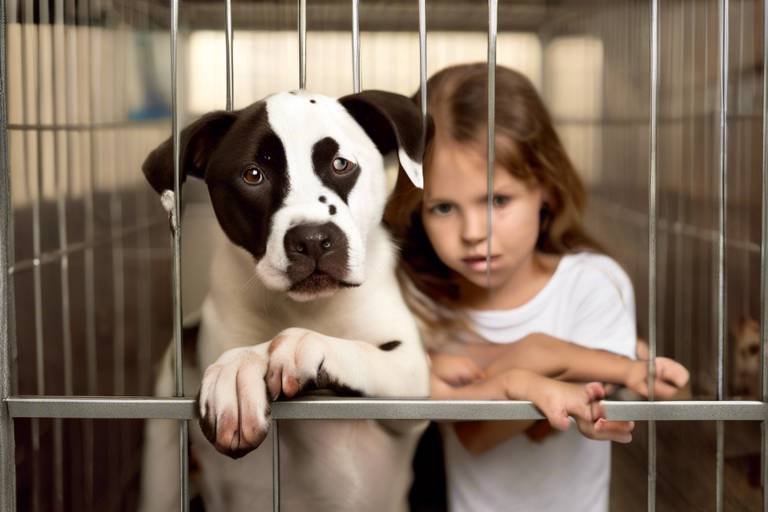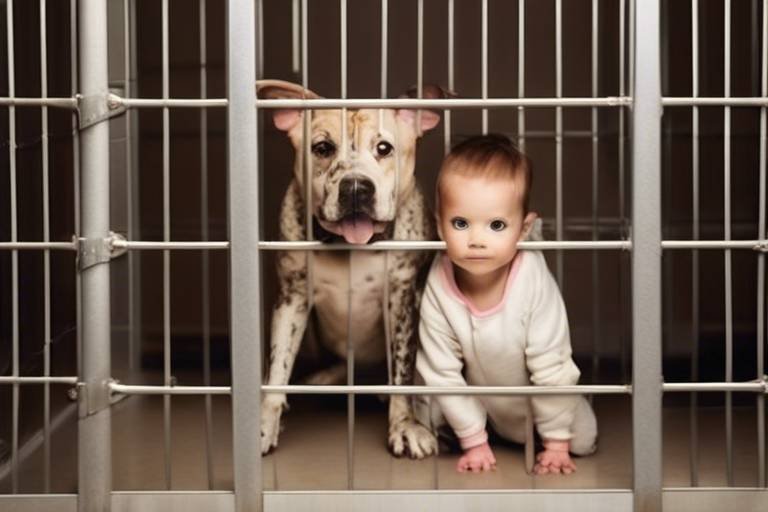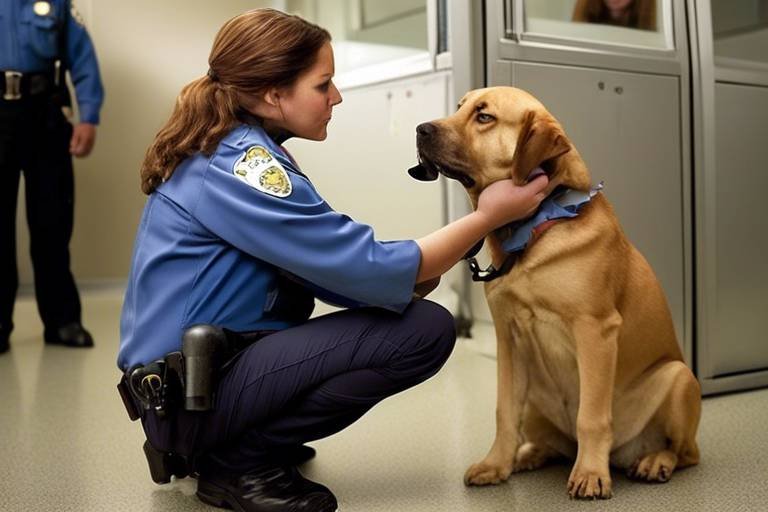The Importance of Empathy in Animal Rescue
When we think about animal rescue, we often picture heroic volunteers rushing to save animals in distress. However, the true magic lies in a deeper emotion that drives these actions: empathy. Empathy is not just a buzzword; it's a crucial element that shapes how we understand and respond to the needs of animals in dire situations. This article explores the crucial role empathy plays in animal rescue efforts, highlighting its impact on animal welfare, volunteer motivation, and community engagement. Understanding empathy can transform rescue practices and improve outcomes for animals in need.
Empathy is essential for understanding the needs and emotions of animals. When rescuers approach their work with an empathetic mindset, they are better equipped to recognize the signs of distress or discomfort in animals. This understanding can lead to better care and improved living conditions for rescued animals. For instance, when a volunteer sees a scared dog cowering in a corner, their empathetic response might prompt them to speak softly, offer treats, or give the animal space to feel safe. Such actions can significantly reduce the animal’s stress levels and facilitate a smoother transition into a new environment.
Volunteers are the backbone of animal rescue organizations. Their dedication often stems from a place of empathy, as they connect with the plight of animals in need. When volunteers feel a strong emotional connection to the cause, they are more likely to engage actively and remain committed over time. This section examines how empathy drives volunteer engagement and retention, fostering a dedicated community committed to animal welfare. When volunteers share their experiences, they often recount moments where their empathy for animals led them to take action—whether it was fostering a litter of kittens or organizing a fundraising event. These stories not only inspire others but also create a ripple effect, encouraging more people to join the cause.
Training programs that emphasize empathy can enhance volunteers' skills. By incorporating empathy into training, organizations can improve interactions with animals and increase the effectiveness of rescue efforts. For example, role-playing scenarios where volunteers must respond to an animal's needs can help them practice empathetic responses in a safe environment. This hands-on approach allows volunteers to understand the emotional states of animals better and respond appropriately, ultimately leading to more successful rescues.
Implementing best practices in training can foster empathy among volunteers. Here are a few effective methods:
- Interactive Workshops: Engage volunteers in activities that simulate animal behavior and emotional responses.
- Guest Speakers: Invite animal behaviorists or psychologists to discuss the emotional needs of animals.
- Feedback Sessions: Create opportunities for volunteers to share their experiences and learn from each other.
Assessing empathy levels in volunteers can help organizations tailor their training programs. Various tools and techniques can be employed to measure empathy, such as self-assessment questionnaires and observational studies. By understanding where a volunteer stands on the empathy spectrum, organizations can provide targeted training that enhances their skills and emotional awareness, leading to more effective rescue operations.
Building community support is vital for animal rescue. Empathy can strengthen community ties and encourage local involvement in rescue initiatives. When community members see the passion and care that volunteers exhibit towards animals, they are more likely to contribute their time, resources, or even adopt pets. Engaging the community through events like adoption days or educational workshops can also foster a culture of empathy, making animal welfare a shared responsibility.
Understanding animal behavior through an empathetic lens is crucial for successful rescue operations. The ability to recognize the emotional states of rescued animals can greatly influence the outcomes of their rehabilitation. For instance, an animal that has been neglected may exhibit fear or aggression. An empathetic rescuer will take the time to understand these behaviors instead of reacting negatively, which can lead to a more positive recovery experience for the animal.
Many rescued animals experience trauma, which can manifest in various behavioral issues. This is where empathy plays a pivotal role. By approaching these animals with understanding and compassion, rescuers can create a safe space that encourages healing. Techniques such as gentle handling, patience, and consistent routines can help traumatized animals rebuild trust and confidence.
Empathetic interactions can significantly influence adoption outcomes. When potential adopters visit shelters, their experience can be greatly enhanced by the empathetic approach of the staff and volunteers. Fostering empathy in animal shelters can lead to higher adoption rates and better matches between pets and families. For example, when staff take the time to understand a family’s lifestyle and preferences, they can recommend animals that are more likely to thrive in that environment, leading to successful and lasting adoptions.
Q1: Why is empathy important in animal rescue?
A1: Empathy helps rescuers understand the emotional and physical needs of animals, leading to better care and improved outcomes.
Q2: How can I become more empathetic towards animals?
A2: Engage in volunteer work, educate yourself about animal behavior, and practice active listening when interacting with animals.
Q3: What role do volunteers play in animal rescue?
A3: Volunteers provide essential support, from direct care of animals to fundraising and community outreach, making them vital to rescue organizations.
Q4: How can organizations measure empathy in their volunteers?
A4: Organizations can use self-assessment tools, observational studies, and feedback sessions to gauge the empathy levels of their volunteers.

The Role of Empathy in Animal Welfare
Empathy is not just a buzzword; it's a vital ingredient in the recipe for effective animal welfare. When we talk about empathy in the context of animal rescue, we refer to the ability to understand and share the feelings of our furry friends. Imagine walking in their paws for just a moment—what would it be like to be abandoned, scared, or in pain? By fostering empathy, we can create a profound shift in how we approach the care and rehabilitation of rescued animals. This understanding goes beyond basic needs; it dives deep into the emotional and psychological states of these creatures.
When rescue organizations embrace an empathetic approach, the results can be transformative. For example, empathetic caregivers are more likely to recognize subtle signs of distress in animals. This awareness allows them to provide tailored care that addresses not only physical ailments but also emotional needs. It’s akin to being a skilled detective, piecing together clues about what an animal has endured, which can lead to better living conditions and a more supportive environment for recovery.
Moreover, empathy in animal welfare promotes a holistic view of care. Instead of merely meeting the basic requirements—food, shelter, and medical attention—an empathetic approach encourages caregivers to consider the following:
- Emotional well-being: Recognizing that animals experience fear, anxiety, and joy can lead to better interactions and care practices.
- Socialization: Understanding that many rescued animals may have been isolated or mistreated informs how we introduce them to new environments and people.
- Long-term rehabilitation: Empathy allows caregivers to develop more effective rehabilitation programs that address both physical and emotional recovery.
Ultimately, when animals feel understood and cared for, their chances of thriving increase exponentially. This empathetic approach not only improves the quality of life for rescued animals but also enhances the overall mission of animal welfare organizations. It fosters a culture of compassion, which can inspire others to get involved. When potential volunteers and donors see the positive impact of empathy in action, they are more likely to contribute their time and resources.
In conclusion, empathy is the heartbeat of animal welfare. It shapes our understanding of the needs and emotions of animals, ultimately leading to better care and improved living conditions. As we continue to advocate for those who cannot speak for themselves, let us remember that empathy is the bridge that connects us to the animals we strive to help.

When it comes to animal rescue, volunteers are the unsung heroes, often dedicating their time and energy to make a difference in the lives of animals in need. But what keeps these compassionate individuals engaged and motivated? The answer lies in a powerful emotion: empathy. Empathy is not just a buzzword; it’s a driving force that fuels passion and commitment among volunteers. When volunteers can connect on an emotional level with the animals they help, it creates a sense of purpose that transcends mere duty.
Empathy allows volunteers to see the world from an animal's perspective. Imagine walking in the paws of a frightened dog or a timid cat—understanding their fears and needs can transform the way volunteers approach their work. This emotional connection fosters a nurturing environment where animals feel safe and cared for. When volunteers genuinely understand the plight of the animals they rescue, they are more likely to go above and beyond in their efforts, whether that means spending extra hours at the shelter or advocating for better living conditions.
Moreover, empathy serves as a bonding agent within the volunteer community. When individuals share their experiences and feelings, it creates a supportive network that enhances morale and reduces burnout. Volunteers often face emotional challenges, witnessing the suffering of animals can take a toll. However, when they share these experiences with empathetic peers, it can lighten the emotional load. This sense of community not only helps retain volunteers but also attracts new ones who are drawn to a compassionate and understanding environment.
To illustrate the impact of empathy on volunteer motivation, consider the following table:
| Empathy Level | Volunteer Engagement | Retention Rate |
|---|---|---|
| Low | Minimal involvement | 30% |
| Moderate | Regular participation | 60% |
| High | Active leadership roles | 90% |
This table highlights a clear trend: as empathy levels increase, so do engagement and retention rates. The numbers speak for themselves—when volunteers feel a deep emotional connection to their work, they are more likely to stay committed and engaged.
In conclusion, empathy is not just a soft skill; it’s a vital component of successful animal rescue efforts. By fostering an empathetic environment, organizations can enhance volunteer motivation, leading to better outcomes for both the animals and the dedicated individuals working tirelessly on their behalf. So, the next time you think about volunteering, remember that your ability to empathize can make all the difference, not just for the animals, but for the entire rescue community.
- Why is empathy important in animal rescue? Empathy helps volunteers connect with animals on an emotional level, leading to better care and increased motivation.
- How can organizations foster empathy among volunteers? Training programs that focus on emotional intelligence and shared experiences can enhance empathy.
- What are the benefits of having empathetic volunteers? Empathetic volunteers are more engaged, have higher retention rates, and provide better care for animals.
When it comes to animal rescue, the role of volunteers cannot be overstated. They are the heart and soul of every rescue organization, often stepping in to provide care, comfort, and support to animals in need. However, to truly make a difference, volunteers must be equipped with more than just basic skills; they need to cultivate a deep sense of empathy. Training programs that emphasize empathy can significantly enhance the effectiveness of volunteers, transforming their interactions with animals and improving overall outcomes in rescue efforts.
Imagine walking into a shelter filled with scared, confused animals. Each one has its own story, its own trauma, and its own needs. Volunteers who approach these animals with empathy are better able to understand their emotional states, which can lead to more compassionate care. Empathy allows volunteers to connect with animals on a deeper level, recognizing their fears and anxieties, and responding in a way that fosters trust and safety. This connection is crucial, especially for animals that have faced neglect or abuse.
Empathetic training can take many forms, but it often includes:
- Workshops on animal behavior and psychology
- Role-playing scenarios to practice empathetic communication
- Group discussions to share experiences and insights
By incorporating these elements into training programs, organizations can create an environment that encourages volunteers to step into the paws of the animals they care for. This not only helps in understanding the animals better but also equips volunteers with the skills to handle various situations more effectively. For instance, a volunteer who understands that a dog is barking out of fear rather than aggression is more likely to approach the situation calmly and with care, potentially preventing further trauma for the animal.
Moreover, training that emphasizes empathy can lead to higher volunteer retention rates. When volunteers feel that they are making a meaningful impact, they are more likely to stay engaged and committed to their roles. This sense of purpose can transform a simple volunteer position into a life-changing experience, both for the volunteers and the animals they serve.
In summary, empathy is not just a soft skill; it is a vital component of effective volunteer training in animal rescue. By focusing on empathetic approaches, organizations can ensure that their volunteers are not only skilled but also compassionate, leading to better outcomes for animals in need. This creates a ripple effect, strengthening the entire rescue community and enhancing the welfare of countless animals.
When it comes to animal rescue, fostering a culture of empathy is not just a nice-to-have; it's a game changer. Training volunteers with an empathetic approach can significantly enhance their ability to connect with animals and understand their needs. So, what are some of the best practices for implementing empathetic training in animal rescue organizations? Let's dive into a few key strategies that can make all the difference.
First and foremost, storytelling is a powerful tool in empathetic training. By sharing real-life stories of rescued animals, trainers can evoke emotional responses that help volunteers understand the struggles these animals face. For instance, discussing a particular dog's journey from abuse to recovery can create a deeper emotional connection, inspiring volunteers to approach their work with compassion and dedication. This narrative-driven approach not only raises awareness but also humanizes the animals, making their plight more relatable.
Another effective practice is to incorporate hands-on experiences into training sessions. Engaging volunteers in direct interactions with animals allows them to observe behaviors and emotions firsthand. This experiential learning can be enhanced by creating scenarios where volunteers must respond to various animal behaviors, encouraging them to think critically about the emotional states of the animals in their care. Such activities not only build empathy but also develop problem-solving skills that are crucial in rescue situations.
Moreover, fostering an environment of open communication among volunteers can amplify the empathetic training experience. Encouraging volunteers to share their feelings, experiences, and challenges creates a support network that nurtures empathy. Regular debriefing sessions where volunteers can discuss their emotional responses to their work can help normalize feelings of sadness or frustration, allowing them to process these emotions constructively.
To measure the effectiveness of empathetic training, organizations can implement feedback mechanisms. Utilizing surveys or informal discussions to gather volunteers' insights on their training experiences can provide valuable data. This feedback can help trainers refine their methods and ensure that the training is meeting its goals of fostering empathy. Additionally, recognizing and celebrating volunteers who demonstrate exceptional empathy can reinforce these behaviors within the community.
In summary, the best practices for empathetic training in animal rescue organizations focus on storytelling, hands-on experiences, open communication, and feedback mechanisms. By integrating these strategies, organizations can cultivate a dedicated team of volunteers who not only understand the animals they serve but are also motivated to advocate for their well-being. Ultimately, this empathetic approach can lead to better outcomes for both animals and the communities that support them.
- What is empathetic training? Empathetic training focuses on developing understanding and compassion in volunteers, enabling them to connect with animals on an emotional level.
- How can storytelling improve empathy? Storytelling evokes emotions and helps volunteers relate to the experiences of animals, fostering a deeper understanding of their needs.
- Why are hands-on experiences important? Direct interactions with animals allow volunteers to observe behaviors and emotional states, enhancing their empathetic responses.
- How can organizations measure empathy in volunteers? Organizations can use surveys, feedback sessions, and recognition programs to assess and promote empathetic behaviors among volunteers.
Measuring empathy in volunteers is not just a *task*, but a **transformative journey** that can significantly enhance the effectiveness of animal rescue organizations. Understanding the levels of empathy among volunteers can provide critical insights into how they interact with animals and each other. This, in turn, can lead to improved training programs and a more compassionate atmosphere within the organization. So, how do we go about measuring something as intangible as empathy?
One effective method is through **self-report surveys**. These surveys can include questions that allow volunteers to reflect on their feelings and attitudes towards animals and their experiences in the rescue environment. For example, questions might ask volunteers to rate their agreement with statements like, “I feel a strong emotional connection to the animals I work with.” This kind of introspective approach not only helps gauge empathy levels but also encourages volunteers to engage in self-reflection, which is a vital part of personal growth.
Another approach is through **behavioral assessments**. Observing how volunteers interact with animals during training sessions or adoption events can provide valuable data. Are they patient and gentle? Do they show concern for an animal's emotional state? These behaviors can be indicators of empathy. To facilitate this, organizations can create a structured observation checklist that focuses on key empathetic behaviors, such as:
- Active listening skills when discussing animal needs
- Gentle handling of animals
- Willingness to spend extra time comforting scared or anxious animals
Furthermore, **peer assessments** can also play a crucial role in measuring empathy. Volunteers can evaluate each other’s interactions with animals and provide constructive feedback. This not only promotes a culture of empathy but also fosters a sense of community among volunteers. Imagine a scenario where a volunteer notices a colleague’s exceptional ability to calm a frightened dog. By acknowledging this skill, they reinforce the importance of empathy and encourage others to develop similar qualities.
Finally, organizations can utilize **empathy training workshops** that include pre- and post-training assessments. These workshops can incorporate role-playing exercises where volunteers practice responding to various animal behaviors. By comparing empathy scores before and after the training, organizations can quantify the impact of these initiatives. It’s like taking a snapshot of growth, showing how empathy can blossom through targeted efforts.
In conclusion, measuring empathy in volunteers is a multifaceted endeavor that requires a blend of self-assessment, observational techniques, peer feedback, and structured training. By implementing these strategies, animal rescue organizations can not only enhance their volunteer programs but also create a more compassionate environment for the animals in their care.
Q: Why is empathy important in animal rescue?
A: Empathy allows volunteers to connect with animals on an emotional level, leading to better care and improved outcomes for the animals.
Q: How can organizations measure empathy effectively?
A: Organizations can use self-report surveys, behavioral assessments, peer evaluations, and empathy training workshops to measure empathy levels among volunteers.
Q: What are some signs of empathetic behavior in volunteers?
A: Signs include active listening, gentle handling of animals, and a willingness to comfort frightened or anxious animals.
Q: Can empathy training really make a difference?
A: Yes, empathy training can enhance volunteers' skills and improve their interactions with animals, ultimately leading to better rescue outcomes.
When it comes to animal rescue, empathy isn't just a feel-good emotion; it's a powerful tool that can transform the way we connect with our communities. Imagine walking through a neighborhood and seeing a stray dog or a cat in need. What if, instead of just passing by, you felt a deep sense of compassion for that animal? This feeling can ignite a spark within community members, encouraging them to take action. Empathy allows us to step into the paws of those we seek to help, understanding their struggles and the urgency of their plight.
Building community support for animal rescue initiatives is essential, and empathy plays a crucial role in this process. When people feel connected to the cause on an emotional level, they are more likely to get involved. For example, community events that showcase rescued animals can foster a sense of belonging and responsibility among attendees. When individuals witness the transformative power of rescue firsthand, their empathy can lead to increased volunteerism, donations, and even adoptions.
Moreover, empathetic outreach can create a ripple effect. As community members engage with animal rescue organizations, they often share their experiences with friends and family, spreading awareness and inspiring others to join the cause. This is where the magic happens: empathy can turn a single act of kindness into a community-wide movement. Think of it as planting seeds of compassion that can grow into a lush garden of support for animals in need.
To truly harness the power of empathy in community engagement, organizations can implement several strategies:
- Storytelling: Sharing heartwarming stories of rescued animals can evoke emotional responses, making people more inclined to help.
- Collaborative Events: Partnering with local businesses or schools for community events can create a sense of unity and shared purpose.
- Volunteer Programs: Creating opportunities for community members to volunteer can deepen their connection to the cause.
By focusing on these strategies, animal rescue organizations can cultivate an empathetic community that not only cares for animals but also supports one another. This sense of community can lead to sustainable change, ensuring that animals receive the care and love they deserve. After all, when we come together with empathy at the forefront, we can create a world where every animal has a fighting chance at a better life.
Q: How can I get involved in my local animal rescue?
A: There are many ways to get involved! You can volunteer your time, donate supplies or funds, or even foster animals in need. Check with local organizations to see how you can help.
Q: What can I do if I see a stray animal?
A: If you see a stray animal, try to assess the situation safely. If possible, contact a local rescue organization or animal control for assistance. They can provide guidance on how to help the animal.
Q: How does empathy affect adoption rates?
A: Empathy plays a significant role in adoption rates. When potential adopters connect emotionally with animals, they are more likely to choose to adopt. Creating an empathetic environment in shelters can lead to better matches between pets and families.

Understanding animal behavior through an empathetic lens is crucial for successful rescue operations. When we talk about empathy, we're not just discussing a feeling—it's about connecting with the emotional states of animals. Each creature has its own unique experiences and traumas that shape its behavior, much like how our past experiences influence how we react to the world. For instance, a dog that has been abandoned may exhibit signs of fear and distrust towards humans. By recognizing these behaviors as a reflection of their emotional state, we can tailor our approach to help them heal.
Empathy allows us to see beyond the surface. When we observe an animal acting out, instead of labeling it as "bad behavior," we can ask ourselves, "What might have caused this reaction?" This shift in perspective not only enhances our understanding but also informs our actions. For example, an empathetic approach might involve providing a safe space for a scared animal, rather than forcing interaction, which could lead to further trauma. By fostering a safe environment, we enable animals to express their true selves, paving the way for successful rehabilitation.
Moreover, empathy in animal rescue isn't just about understanding individual animals; it's about recognizing patterns of behavior that can inform broader rescue strategies. For instance, certain breeds may be more prone to anxiety or aggression due to their history or environment. By studying these behavioral traits, we can develop targeted interventions that cater to their specific needs. This proactive approach not only improves the welfare of the animals but also enhances the effectiveness of rescue operations.
To illustrate this point, consider the following table that outlines common behavioral issues in rescued animals and empathetic responses that can be employed:
| Behavioral Issue | Possible Cause | Empathetic Response |
|---|---|---|
| Fear of humans | Previous abuse or neglect | Provide a quiet space and gradual exposure |
| Aggression towards other animals | Competition for resources | Introduce slowly and monitor interactions |
| Excessive barking | Stress or anxiety | Engage in calming activities and provide enrichment |
Recognizing these behaviors and responding with empathy not only aids in the individual animal's recovery but also contributes to a more harmonious environment in rescue facilities. When animals feel understood and safe, they are more likely to exhibit positive behaviors, making the rescue process smoother for everyone involved.
In essence, empathy acts as a bridge between humans and animals, allowing us to communicate and connect on a deeper level. By embracing this approach, we can significantly improve the outcomes for animals in need, ensuring they receive the care and understanding they deserve.
- Why is empathy important in animal rescue? Empathy helps us understand the unique needs and emotions of each animal, leading to better care and rehabilitation.
- How can I develop empathy towards animals? Spend time observing animals, learn about their behaviors, and reflect on their experiences to foster a deeper connection.
- What are some signs that an animal may need empathetic care? Signs include fear, aggression, excessive barking, or withdrawal from social interactions.
When it comes to rescuing animals, one of the most challenging aspects is addressing the trauma that many of these creatures have endured. Just like humans, animals can experience profound emotional and psychological scars that affect their behavior and well-being. This is where empathy plays a pivotal role. Understanding the emotional states of traumatized animals allows rescuers to tailor their approaches, ensuring that each animal receives the care and attention it truly needs. Imagine walking into a room filled with frightened souls; the key to reaching them lies in your ability to feel what they feel.
Empathy in handling trauma is not just about being kind; it's about recognizing the signs of distress and responding appropriately. For instance, an animal that cowers in the corner, tail tucked, is not merely being shy; it is expressing fear and a need for safety. By empathizing with their situation, rescuers can create a more supportive environment that encourages healing. This might involve using gentle voices, slow movements, and providing safe spaces where animals can retreat and feel secure.
Moreover, empathetic handling can significantly impact the rehabilitation process. When volunteers and staff approach animals with understanding and compassion, they foster a sense of trust. This is crucial because trust is the foundation upon which recovery is built. For example, a dog that has been abused may initially react with aggression or fear. However, through consistent, empathetic interactions, it can learn to feel safe again. This transformation is not only rewarding for the animal but also for the rescuers who witness the change.
To effectively handle trauma in animals, organizations can implement specific practices that emphasize empathy. Here are some strategies:
- Observation: Spend time observing the animal's behavior before attempting to interact. Understanding their body language can provide insights into their emotional state.
- Gradual Exposure: Introduce new experiences slowly. This helps the animal acclimate without feeling overwhelmed.
- Positive Reinforcement: Use treats and praise to encourage positive behavior, reinforcing the idea that the world can be a safe and loving place.
Additionally, training volunteers to recognize and respond to trauma through empathetic approaches can lead to better outcomes for the animals. Workshops and seminars can equip volunteers with the tools they need to understand the psychological effects of trauma on animals. This not only enhances their skills but also deepens their commitment to animal welfare.
In conclusion, empathy is not just a nice-to-have quality in animal rescue; it's a necessity. By fostering an environment of understanding and compassion, we can help traumatized animals heal and thrive. The journey of recovery may be long and winding, but with empathy as our guiding light, we can make a profound difference in the lives of those who cannot speak for themselves.
Q1: What is the importance of empathy in animal rescue?
A1: Empathy is crucial in animal rescue as it helps rescuers understand the emotional and psychological needs of animals, leading to better care and rehabilitation.
Q2: How can I show empathy towards traumatized animals?
A2: You can show empathy by observing their behavior, using gentle interactions, and providing a safe environment where they can feel secure.
Q3: Why is trust important in rehabilitating traumatized animals?
A3: Trust is essential because it allows animals to feel safe, which is necessary for them to open up and begin the healing process.
Q4: Can training improve a volunteer's empathetic skills?
A4: Yes, training can enhance volunteers' abilities to recognize and respond to the needs of traumatized animals, making them more effective in their roles.
When it comes to animal adoption, the impact of empathy cannot be overstated. Imagine walking into an animal shelter, where the atmosphere is filled with hope and warmth, rather than the coldness that often accompanies the notion of abandonment. Empathy plays a pivotal role in creating this environment, allowing potential adopters to connect on a deeper level with the animals they meet. It's not just about finding a pet; it's about forging a bond that resonates with both human and animal emotions.
Studies have shown that when shelter staff and volunteers display empathy towards animals, it significantly influences the way potential adopters perceive these pets. For instance, an empathetic interaction can help a shy dog come out of its shell, showcasing its true personality. This transformation can lead to a more engaging and relatable experience for the adopter. When adopters see the genuine emotions of the animals, they are more likely to feel a connection, making them more inclined to take that leap of faith and adopt.
Furthermore, empathetic interactions can foster a sense of responsibility and commitment among potential adopters. When individuals understand the emotional needs of a pet, they are more likely to consider the long-term implications of adoption. This understanding can lead to better matches between pets and families, ultimately reducing the chances of animals being returned to shelters. In essence, empathy not only aids in adoption rates but also ensures that these animals find their forever homes in a more thoughtful and informed manner.
To illustrate this point, let’s take a look at a comparison of adoption rates between shelters that prioritize empathy in their interactions versus those that do not:
| Shelter Type | Adoption Rate (%) | Return Rate (%) |
|---|---|---|
| Empathy-Focused Shelters | 75 | 10 |
| Standard Shelters | 50 | 30 |
As shown in the table, shelters that emphasize empathy in their approach see a remarkable increase in adoption rates while simultaneously reducing return rates. This is a clear indicator that when empathy is at the forefront of animal rescue efforts, everyone benefits—most importantly, the animals who are seeking loving homes.
In addition to fostering better adoption outcomes, empathy can also lead to increased community support for animal shelters. When the community witnesses the compassionate care provided to animals, they are more likely to engage in volunteer opportunities and donate resources. This creates a positive feedback loop where empathy not only helps animals find homes but also builds a supportive community around animal welfare.
Ultimately, the impact of empathy on adoption rates is profound. It transforms the adoption process from a transactional experience into a meaningful journey of connection and understanding. When we approach animal rescue with empathy, we open the door to a world where every animal has the chance to find a loving home and every adopter can experience the joy of companionship.
- Why is empathy important in animal adoption? Empathy helps create a deeper connection between potential adopters and animals, leading to better matches and higher adoption rates.
- How can shelters foster empathy among staff and volunteers? Training programs that emphasize emotional understanding and compassionate care can cultivate an empathetic environment.
- What are the benefits of adopting from an empathy-focused shelter? Adopting from such shelters often results in a better understanding of the pet's needs, leading to lower return rates and happier homes.
Frequently Asked Questions
- What is the role of empathy in animal rescue?
Empathy plays a crucial role in animal rescue as it allows rescuers to understand the emotional and physical needs of animals. By fostering empathy, volunteers and organizations can provide better care, improve living conditions, and ultimately enhance the welfare of rescued animals.
- How does empathy influence volunteer motivation?
Empathy significantly boosts volunteer motivation. When volunteers feel a strong emotional connection to the animals they help, they are more likely to stay engaged and committed to rescue efforts. This creates a dedicated community that is passionate about animal welfare.
- What are some best practices for training volunteers in empathy?
Best practices for training volunteers in empathy include interactive workshops, role-playing scenarios, and discussions about animal behavior and emotional needs. These methods help volunteers develop a deeper understanding of the animals they work with, enhancing their ability to provide compassionate care.
- How can organizations measure empathy levels in volunteers?
Organizations can measure empathy levels in volunteers using surveys, self-assessment tools, and observational methods. By assessing these levels, organizations can tailor training programs to better equip volunteers with the skills needed for effective animal rescue.
- Why is community engagement important in animal rescue?
Community engagement is vital for animal rescue as it helps build support networks, encourages local involvement, and raises awareness about animal welfare issues. Empathy strengthens these community ties, making it easier to mobilize resources and volunteers for rescue initiatives.
- How does empathy affect the behavior of rescued animals?
Understanding animal behavior through an empathetic lens allows rescuers to recognize the emotional states of animals, particularly those who have experienced trauma. This knowledge is essential for developing effective rehabilitation strategies and creating a safe environment for recovery.
- What impact does empathy have on adoption rates?
Empathetic interactions in shelters can lead to higher adoption rates. When potential adopters feel a connection with animals, they are more likely to choose them. This fosters better matches between pets and families, ensuring long-term happiness for both.



















